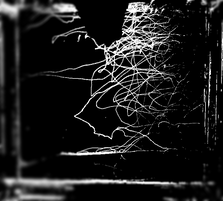How and why are animal behaviors so diverse?
“And the wild things roared their terrible roars and gnashed their terrible teeth and rolled their terrible eyes and showed their terrible claws.”
- Maurice Sendak, Where the Wild Things Are
The animal kingdom is replete with a varied repertoire of behaviors. The roarings, gnashings, and rollings of many a wild thing are considered some of the most captivating and noteworthy examples of phenotypic diversity. I am especially interested in those behaviors used for animal communication - when individuals need to convey information to one another. How do senders create signals? How do receivers understand them? Which evolutionary processes generate or constrain their evolution? And what does this mean for phenotypic and species diversity?
Specifically, my research focuses on understanding the molecular basis for behavioral evolution. I am particularly intrigued by signals used in mating contexts and how receivers make mating decisions. I have primarily used a comparative approach to understand how behaviors have evolved between species.
I have on-going work investigating how biochemical variation in enzyme ability influences diversity in the bioluminescent courtship displays of Caribbean ostracods (also called seed shrimp, sea fireflies, or disco shrimp). I also have data on if and how female ostracods can discriminate differences in these signals between species.
Specifically, my research focuses on understanding the molecular basis for behavioral evolution. I am particularly intrigued by signals used in mating contexts and how receivers make mating decisions. I have primarily used a comparative approach to understand how behaviors have evolved between species.
I have on-going work investigating how biochemical variation in enzyme ability influences diversity in the bioluminescent courtship displays of Caribbean ostracods (also called seed shrimp, sea fireflies, or disco shrimp). I also have data on if and how female ostracods can discriminate differences in these signals between species.
Evolution of behavior
Behavior is one of the most flexible phenotypes; its plasticity can be on the millisecond timescale, such as in decision-making processes. However, even with its extreme lability, behavior can show phylogenetic conservation. Studying behavior at both contemporary and historical timescales allows us to better understand the role behavioral variation plays in both microevolutionary processes and macroevolutionary patterns. This framework, first proposed by Nikolaas Tinbergen, sets the stage for developing an integrative understanding of how and why behaviors appear as we observe. I use these complementary levels of analyses in both my past and current projects:
- Hensley, N. M., Drury, J. P., Garland Jr, T., & Blumstein, D. T. (2015). Vivid birds do not initiate flight sooner despite their potential conspicuousness. Current Zoology.
- In collaboration with others, I am investigating the emergence of extreme synchrony in mating signals among newly discovered species of Panamanian ostracods.
- While describing these two new species, I am also documenting the first evidence of hybridization in this group
Molecular mechanisms of behavior
Behaviors are complex phenotypes, and as such, are likely to be influenced by a great number of genetic markers. But the relative contribution of these loci to any given behavior, or how a behavior changes between species, is very much an unresolved question due to its difficulty in assessing. Only a handful of studies successfully link specific loci to evolutionary changes in behavior. I am exploring how changes in a candidate gene encoding a key bioluminescence enzyme ("c-luciferase") influences signal form in ostracod bioluminescent displays.
- Hensley, N. M., Ellis, E. A., Gerrish, G. A., Torres, E., Frawley, J. P., Oakley, T. H. & Rivers, T. J. Phenotypic evolution shaped by current enzyme function in the bioluminescent courtship signals of sea fireflies. Proceedings of the Royal Society B 286, 20182621 (Jan. 2019).
- Hensley, N. M., Ellis, E. A., Leung, N. Y., Coupart, J., Mikhailovsky, A., Taketa, D. A., Tessler, M., Gruber, D. F., Mitani, Y., DeTomaso, A. W., Rivers, T. J., Gerrish, G. A., Torres, E. & Oakley, T. H. Selection, drift, and constraint in cypridinid luciferases and the diversification of bioluminescent signals in sea fireflies. Molecular Ecology. (Oct. 2020)
Eco-evolutionary dynamics and behavioral variation
Behavior is a responsive phenotype, sensitive to ecological cues that can influence its current form and potential evolutionary trajectory. Classically, animal behavior was solely under the purview of ethology or behavioral ecology. With the modern shift towards a more integrative understanding of behavioral phenotypes, keeping in mind their natural history context is paramount to understanding behavioral evolution. I have looked at behavioral-ecological correlates in a few projects:
- Hensley, N. M., Cook, T. C., Lang, M., Petelle, M. B., & Blumstein, D. T. (2012). Personality and habitat segregation in giant sea anemones (Condylactis gigantea). Journal of Experimental Marine Biology and Ecology.
- Using automated tracking from DeepLabCut, I am also looking at how varying levels of allopatry and sympatry influence female discrimination behaviors among four species of bioluminescent ostracods.
Future directions
In ostracods, I have been able to ask what kinds of evolutionary and ecological processes shape variation in signals and preferences. Because these (and other) mating displays are multivariate phenotypes, I've been increasingly curious about how the brain perceives and evaluates the informational content within such signals. Given the prominent role that mate choice plays in sexual selection and speciation, I'm most interested in seeing how perceptual and cognitive mechanisms have evolved to produce diverse preference functions. Moving forward, I'd like to leverage more functional tests in genetics and neuroscience to address proximate mechanisms in the behavioral variation of mate choice.
Previous work
Before pursuing a graduate degree, I worked on a variety of topics exploring questions in the evolutionary development of cnidarians, and in community ecology of macroalgae on shallow reefs. Please refer to my Google Scholar for that work.
Banner: The bioluminescent courtship displays of Caribbean ostracods. Each vertical trail of lights is the display of a single male ostracod. Credit: Martin Dohrn (Ammonite Films) and Dr. Gretchen A. Gerrish.




